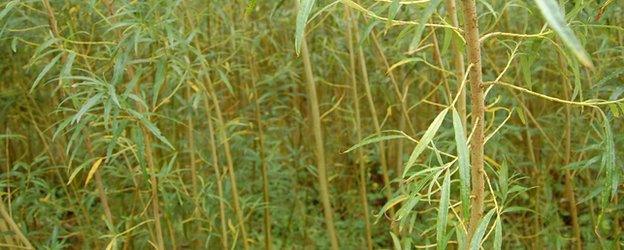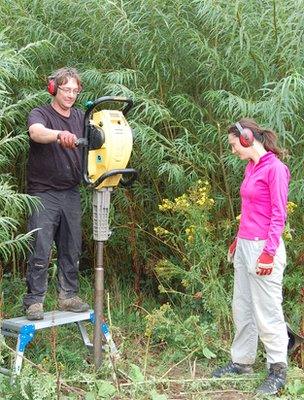Measuring bioenergy crops' carbon footprint credentials
- Published

Bioenergy crops, like willow, could play a key role in delivering a low carbon future, the government says
Generation of electricity and heat from plant material is listed in the suite of renewable energy technologies that the UK governments think can help deliver 15% of the nations' energy consumption by 2020.
The UK Renewable Energy Roadmap, external says measures being introduced will "ensure that low-carbon electricity from a diverse range of sources... becomes a more attractive choice for investors, delivering long-term change while minimising cost to the consumer".
In its UK Bioenergy Strategy, external, published in April 2012, the coalition government placed high importance on the role biomass can play, warning that excluding it from the energy mix would "significantly increase the cost of decarbonising our energy system - an increase estimated by recent analysis at £44bn".
Mark Kinver visits scientists in their outdoor laboratory in Lincolnshire
However, it added that ministers had a responsibility to ensure that "policies only supported bioenergy use in the right circumstances".
The strategy document outlined four guiding principles that would underpin policy decisions, one of which stated:
"Policies that support bioenergy should deliver genuine carbon reductions that help meet UK carbon emission objectives to 2050 and beyond."
The UK introduced the Climate Change Act 2008, which obliges governments to deliver an 80% reduction in greenhouse gas emission from 1990 levels by 2050.
Experts agree that in order for this target to be met, the UK's energy infrastructure must drastically cut its carbon footprint.
Outdoor laboratory
In a Lincolnshire field, a team of scientists led by researchers from the Centre for Ecology and Hydrology (CEH) carried out a range of experiments on two bioenergy crops: miscanthus grass and short-rotation coppice willow.
In their outdoor laboratory, they set out to measure how much atmospheric carbon the crops were able to lock in the soil.
"The big barrier as far as bioenergy crops are concerned is a fear of the unknown in terms of soil carbon losses or gains - this is the gap we are trying to fill," explained lead researcher Niall McNamara.
"At this field site, we are very lucky to have two key bioenergy crops growing side-by-side, which is allowing us to make a comparison of their effects on soil carbon and greenhouse gas emissions from the soil," he told BBC News.
One of the experiments involves erecting three-metre high tents over a section of the crops, allowing the team to expose the plants to a "carbon tracer" - a form of carbon that is different from atmospheric carbon so it is possible for the researchers to track its movements from the surrounding air, through the plants and into the soil.
"This is added through the tent for about four to five hours," said Dr McNamara.
"During this time, it is fixed by the plants through photosynthesis. We then follow that carbon which has been fixed by the plant into the soil and into the microbes and back out of the soil."
He added that the experiment would provide data on how novel crops, such as miscanthus, introduced carbon into the soil and how stable it was once it was in the ground.
"As you can see, miscanthus is very different from anything you would see normally," he observed.
"It originates from Asia and so there has not been a lot of work done on it and the carbon tracer approach is a very good way of seeing how much carbon fixed by the plant will stay in the soil a year later."
Another experiment the team are carrying out involves taking a metre-deep soil sample, which co-researcher Rebecca Rowe describes as "quite unusual".
"A lot of soil science, at the moment, is done to about 30cm, partly for practical reasons as coring to a metre is difficult," she said.
Digging deep
In order to extract the metre-long sample, the team have to enlist the help of "Kevin", an adapted road-breaker.

Dr McNamara (left) and Dr Rowe use "Kevin", an adapted road-breaker, to collect a soil sample
"Also because a lot of arable crops or grassland crops the rooting depths are much shallower, a lot of the changes are happening in the top 30cm," Dr Rowe told BBC News.
"Obviously, with energy crops that are in the ground for 20-25 years, we are looking at a lot longer timescale and a greater depth for rooting so it is important for us to go deeper."
Dr Rowe is 12 months into a three-year project that involves collecting metre soil samples all over the UK.
"We could just do it here at our Lincolnshire site, but then we would only be able to say what is happening with soil carbon in this location in this soil type," she explained.
"By going all over the country, we can look at different soil types and different climates - the South-West is very different to, say, southern Scotland.
"It gives us a much better idea of what the overall effect on soil carbon may be in all of the sites across the UK with growing things like willow, miscanthus and different arable crops as well."
Dr McNamara said the data would be used to develop a model, developed by researchers from Aberdeen University and other partners, to show how growing bioenergy crops would affect an area of land's soil carbon characteristics.
"Our plan is to make a model universally available to the community, so a user could download our model and then - for example - predict what would happen if they converted their land to bioenergy crops in terms of the implication for soil carbon and greenhouse gas emissions," he said.
The project - commissioned and funded by the Energy Technologies Institute, with additional funding from the Natural Environment Research Council - would, Dr McNamara added, help address the concern over the scarcity of data on bioenergy crops and carbon cycling, and allow policymakers make informed decisions about the role bioenergy can play in delivering a low carbon UK energy mix.
- Published16 March 2012
- Published9 May 2011
- Published13 March 2012